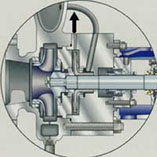 "Multiplicity ought not to be posited without necessity." — Occam's Razor Otherwise stated: |
Articles about Split Flow™
U.S. Patent Office issues patent for ‘Big’ Split Flow™The United States Patent Office has issued the patent for the 2015 edition of Split Flow — an innovative API centrifugal pump that employs two different impellers in the same pump casing. The new Split Flow applies to both overhung and between bearing pumps. The new patent is a substantial upgrade from the original, 1997 version of Split Flow, which only covered overhung pumps. Big Split Flow™
The basics of the new Split Flow™Essential facts, specifications and parameters of the new Split Flow patent. Little Split Flow™
Split Flow facts and applicationsWhen process designs use API Standard 610 centrifugal pumps for Dual-Service applications, use of the Split Flow™ feature provides unique benefits, detailed here. Split Flow process pumps save energyApplication for U.S. Department of Energy National Industrial Competitiveness Through Energy, Environment, and Economics (Nice 3) Program. Includes many important Split Flow facts. Carbon dioxide reductionsThe efficiency of the Split Flow application saves energy, and thus reduces carbon emissions — anywhere from 233 to 433 metric tonnes of CO2 per year. The Split Flow™ optionEngineers in every discipline need to be alert for opportunities to save capital and reduce operating costs. The Split Flow™ option is a new way of reducing operating and capital costs for auxiliary systems. Process engineering assessmentsSplit Flow provides cost-saving option to common process problem. Summary comparison of Big and Little Split Flow featuresSplit Flow displays and comparisonsTypical pump services with crude atmospheric distillation tower
|
About Split Flow™U.S. Patent Office issues patent for ‘Big’ Split Flow™ The basics of the new Split Flow™ Basic Split Flow facts and applications Criteria for use of Split Flow Process engineering assessments Little Split Flow design configuration options Summary comparison of Big and Little Split Flow features Split Flow displays and comparisons Typical pump services with crude atmospheric distillation tower API Standard 610 and overhung pumps Capital and operating savings at Shell refinery “The obvious often escapes us.” |



 API Standard 610 and overhung pumps
API Standard 610 and overhung pumps